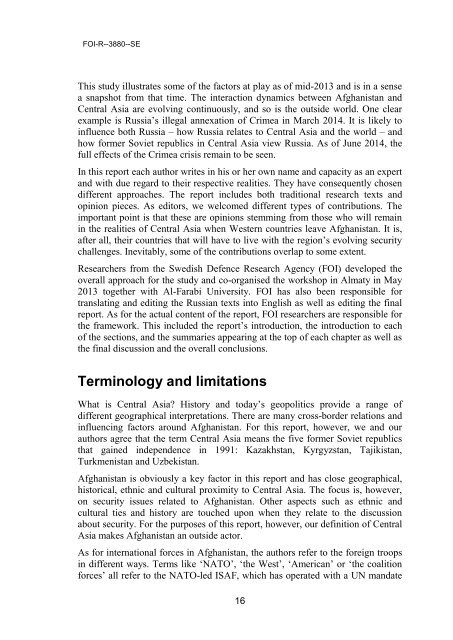foir_3880
foir_3880
foir_3880
Create successful ePaper yourself
Turn your PDF publications into a flip-book with our unique Google optimized e-Paper software.
FOI-R--<strong>3880</strong>--SE<br />
This study illustrates some of the factors at play as of mid-2013 and is in a sense<br />
a snapshot from that time. The interaction dynamics between Afghanistan and<br />
Central Asia are evolving continuously, and so is the outside world. One clear<br />
example is Russia’s illegal annexation of Crimea in March 2014. It is likely to<br />
influence both Russia – how Russia relates to Central Asia and the world – and<br />
how former Soviet republics in Central Asia view Russia. As of June 2014, the<br />
full effects of the Crimea crisis remain to be seen.<br />
In this report each author writes in his or her own name and capacity as an expert<br />
and with due regard to their respective realities. They have consequently chosen<br />
different approaches. The report includes both traditional research texts and<br />
opinion pieces. As editors, we welcomed different types of contributions. The<br />
important point is that these are opinions stemming from those who will remain<br />
in the realities of Central Asia when Western countries leave Afghanistan. It is,<br />
after all, their countries that will have to live with the region’s evolving security<br />
challenges. Inevitably, some of the contributions overlap to some extent.<br />
Researchers from the Swedish Defence Research Agency (FOI) developed the<br />
overall approach for the study and co-organised the workshop in Almaty in May<br />
2013 together with Al-Farabi University. FOI has also been responsible for<br />
translating and editing the Russian texts into English as well as editing the final<br />
report. As for the actual content of the report, FOI researchers are responsible for<br />
the framework. This included the report’s introduction, the introduction to each<br />
of the sections, and the summaries appearing at the top of each chapter as well as<br />
the final discussion and the overall conclusions.<br />
Terminology and limitations<br />
What is Central Asia History and today’s geopolitics provide a range of<br />
different geographical interpretations. There are many cross-border relations and<br />
influencing factors around Afghanistan. For this report, however, we and our<br />
authors agree that the term Central Asia means the five former Soviet republics<br />
that gained independence in 1991: Kazakhstan, Kyrgyzstan, Tajikistan,<br />
Turkmenistan and Uzbekistan.<br />
Afghanistan is obviously a key factor in this report and has close geographical,<br />
historical, ethnic and cultural proximity to Central Asia. The focus is, however,<br />
on security issues related to Afghanistan. Other aspects such as ethnic and<br />
cultural ties and history are touched upon when they relate to the discussion<br />
about security. For the purposes of this report, however, our definition of Central<br />
Asia makes Afghanistan an outside actor.<br />
As for international forces in Afghanistan, the authors refer to the foreign troops<br />
in different ways. Terms like ‘NATO’, ‘the West’, ‘American’ or ‘the coalition<br />
forces’ all refer to the NATO-led ISAF, which has operated with a UN mandate<br />
16


